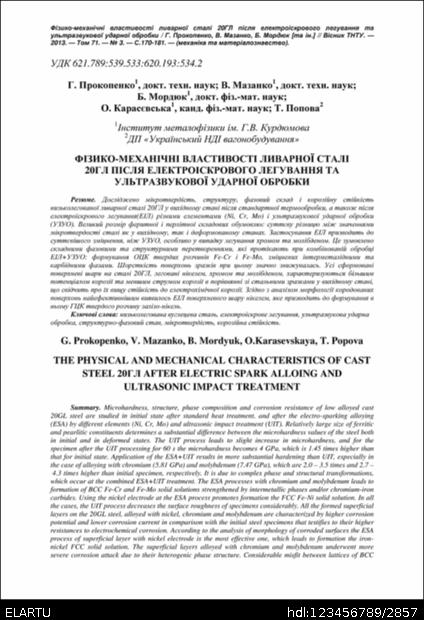Utilize este identificador para referenciar este registo:
http://elartu.tntu.edu.ua/handle/123456789/2857

| Título: | Фізико-механічні властивості ливарної сталі 20ГЛ після електроіскрового легування та ультразвукової ударної обробки |
| Outros títulos: | The physical and mechanical characteristics of cast steel 20ГЛ after electric spark alloing and ultrasonic impact treatment |
| Autor: | Прокопенко, Г. Мазанко, В. Мордюк, Б. Карасєвська, О. Попова, Т. Prokopenko, G. Mazanko, V. Mordyuk, B. Karasevskaya, O. Popova, T. |
| Bibliographic description (Ukraine): | Фізико-механічні властивості ливарної сталі 20ГЛ після електроіскрового легування та ультразвукової ударної обробки / Г. Прокопенко, В. Мазанко, Б. Мордюк [та ін.] // Вісник ТНТУ. — 2013. — Том 71. — № 3. — С.170-181. — (механіка та матеріалознавство). |
| Data: | 15-Ago-2013 |
| Date of entry: | 17-Fev-2014 |
| Editora: | Тернопільський національний технічний університет ім. Івана Пулюя |
| Place of the edition/event: | Тернопіль, Україна |
| UDC: | 621.789 539.533 620.193 534.2 |
| Palavras-chave: | низьколегована вуглецева сталь електроіскрове легування ультразвукова ударна обробка структурно-фазовий стан мікротвердість корозійна стійкість low alloyed carbon steel electro-spark alloying ultrasonic impact treatment structural and phase state microhardness corrosion resistance |
| Resumo: | Досліджено мікротвердість, структуру, фазовий склад і корозійну стійкість низьколегованої ливарної сталі 20ГЛ у вихідному стані після стандартної термообробки, а також після електроіскрового легування(ЕІЛ) різними елементами (Ni, Cr, Mo) і ультразвукової ударної обробки (УЗУО). Великий розмір феритної і перлітної складових обумовлює суттєву різницю між значеннями мікротвердості сталі як у вихідному, так і деформованому станах. Застосування ЕІЛ призводить до суттєвішого зміцнення, ніж УЗУО, особливо у випадку легування хромом та молібденом. Це зумовлено складними фазовими та структурними перетвореннями, які протікають при комбінованій обробці ЕІЛ+УЗУО: формування ОЦК твердих розчинів Fe-Cr і Fe-Mo, зміцнених інтерметалідними та карбідними фазами. Шорсткість поверхонь зразків при цьому значно знижувалась. Усі сформовані поверхневі шари на сталі 20ГЛ, леговані нікелем, хромом та молібденом, характеризуються більшим потенціалом корозії та меншим струмом корозії в порівнянні зі стальними зразками у вихідному стані, що свідчить про їх вищу стійкість до електрохімічної корозії. Згідно з аналізом морфології кородованих поверхонь найефективнішим виявилось ЕІЛ поверхневого шару нікелем, яке призводить до формування в ньому ГЦК твердого розчину залізо-нікель. Microhardness, structure, phase composition and corrosion resistance of low alloyed cast 20GL steel are studied in initial state after standard heat treatment, and after the electro-sparking alloying (ESA) by different elements (Ni, Cr, Mo) and ultrasonic impact treatment (UIT). Relatively large size of ferritic and pearlitic constituents determines a substantial difference between the microhardness values of the steel both in initial and in deformed states. The UIT process leads to slight increase in microhardness, and for the specimen after the UIT processing for 60 s the microhardness becomes 4 GPa, which is 1.45 times higher than that for initial state. Application of the ESA+UIT results in more substantial hardening than UIT, especially in the case of alloying with chromium (5.81 GPa) and molybdenum (7.47 GPa), which are 2.0 – 3.5 times and 2.7 – 4.3 times higher than initial specimen, respectively. It is due to complex phase and structural transformations, which occur at the combined ESA+UIT treatment. The ESA processes with chromium and molybdenum leads to formation of BCC Fe-Cr and Fe-Mo solid solutions strengthened by intermetallic phases and/or chromium-iron carbides. Using the nickel electrode at the ESA process promotes formation the FCC Fe-Ni solid solution. In all the cases, the UIT process decreases the surface roughness of specimens considerably. All the formed superficial layers on the 20GL steel, alloyed with nickel, chromium and molybdenum are characterized by higher corrosion potential and lower corrosion current in comparison with the initial steel specimens that testifies to their higher resistances to electrochemical corrosion. According to the analysis of morphology of corroded surfaces the ESA process of superficial layer with nickel electrode is the most effective one, which leads to formation the iron-nickel FCC solid solution. The superficial layers alloyed with chromium and molybdenum underwent more severe corrosion attack due to their heterogenic phase structure. Considerable misfit between lattices of BCC solid solutions (Fe-Cr or Fe-Mo) and intermetallic or carbide phases with crystalline lattices of low symmetry results in formation of defects and stresses can also promote higher corrosion rate. |
| URI: | http://elartu.tntu.edu.ua/handle/123456789/2857 |
| ISSN: | 1727-7108 |
| Copyright owner: | © „Вісник Тернопільського національного технічного університету“ |
| Publications status : | Опубліковано раніше |
| Content type: | Article |
| Aparece nas colecções: | Вісник ТНТУ, 2013, № 3 (71) |
Ficheiros deste registo:
Todos os registos no repositório estão protegidos por leis de copyright, com todos os direitos reservados.